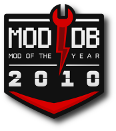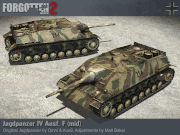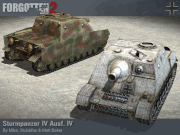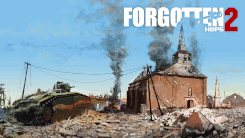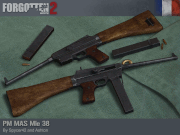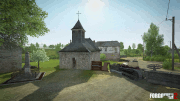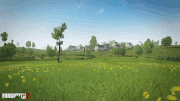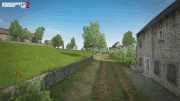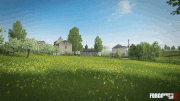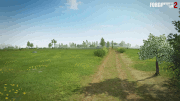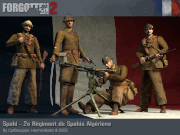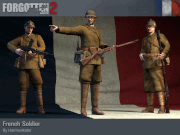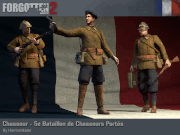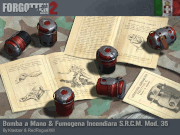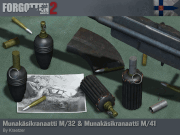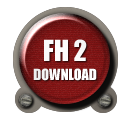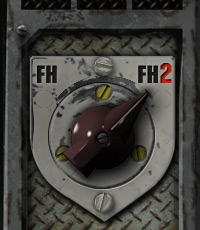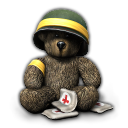 |
||
|
|
||
 |
||
|
ARCHIVES >>> 5/2022
29.05.2022 19:00 GMT
Hello and welcome back to another Forgotten Hope 2 update. Today we are announcing a D-Day themed event that will run over next weekend from Saturday 4th June to Sunday 5th June. We will be playing a series of our D-Day maps, as well as a couple of event maps adapted from CMP:
We are hoping to be able to run more events like this in the future - focused on a small subset of our maps with some extra event maps added to the mix. You will receive a small update through the game launcher this week before the event that will download the event maps automatically. That's all for this week, but be sure to come back next time for another update. Until then, feel free to visit our Discord, our public forums, our Twitter, our subreddit, and/or Facebook pages to discuss this update and other news.
The Road to Forgotten Hope 2.61 by: Eat Uranium 26.05.2022 10:30 GMT
Hello and welcome back to another Forgotten Hope 2 update. We are pleased to announce that Forgotten Hope 2.61 is now live! You can download it by starting the Launcher. New and returning players can download the launcher from our downloads page. We hope to see you on the battlefield! This is a smaller update to fix a few problems and balance issues identified in our recent 2.6 release. This includes: We hope to see you on the servers soon! That's all for this week, but be sure to come back next time for another update. Until then, feel free to visit our Discord, our public forums, our Twitter, our subreddit, and/or Facebook pages to discuss this update and other news.
The Road to Forgotten Hope 2.6 - Part 7 by: Eat Uranium 13.05.2022 08:00 GMT

Hello and welcome back to another Forgotten Hope 2 update. We are pleased to announce that the 2.6 update is now live on the launcher. For those of you who downloaded the password protected files, the password is: T0n$ofD3vsL07s0fC0n7en7 We hope to see you on the server soon! While you wait for the update to download and install, why not catch up on some of the recent dev blogs and videos:
If you have missed any previous updates this week, you can find links to them here: That's all for today, but be sure to come next time for another update. Until then, feel free to visit our Discord, our public forums, our Twitter, our subreddit, and/or Facebook pages to discuss this update and other news.
The Road to Forgotten Hope 2.6 - Part 6.5 by: kummitus 11.05.2022 21:45 GMT

Hello and welcome back to another Forgotten Hope 2 update. The pre-download is now available, either as torrent or direct download You'll need 7-Zip to unpack the files. Password will be provided on Friday.Happy Downloading! In addition, we'd like to announce that 2.6 features support for 2 additional languages:
That's all for today, but be sure to come back on Friday for the release! Until then, feel free to visit our Discord, our public forums, our Twitter, our subreddit, and/or Facebook pages to discuss this update and other news.
The Road to Forgotten Hope 2.6 - Part 6 by: Eat Uranium 11.05.2022 18:00 GMT

Hello and welcome back to another Forgotten Hope 2 update. Today we are showing off our final new content coming in version 2.6. It has certainly felt like a marathon week of news, but we are now only 2 days away from seeing you all on the servers. The concept of an armoured vehicle dedicated to the role of destroying tanks had first been realised by the Germans as the Panzerjäger I. While this vehicle proved the concept, it was quickly getting long in the tooth, especially when compared to the towed PaK 40 anti-tank cannons that were starting to appear at the front through 1942. The hasty rush to get this gun into a similar armoured self propelled mount lead to the Marder series of vehicles, before finally settling on upgunning the StuG. The 7.5 cm L/48 armed StuGs were an instant success: cheap and quick to manufacture and very effective on the battlefield in their new anti-tank role. With this in mind, the requirements for new design of StuG were issued in September of 1942: thicker armour, lower height and mounting the new 7.5 cm L/70 gun. Several designs were submitted, with that by Vomag being accepted. It was based on the Panzer IV hull, modified with a low armoured casemate and sloped frontal armour. The L/70 gun was needed to arm the new Panther tanks, and so the first production of the new vehicles were armed with the older L/48. Production started in December 1943, several months behind schedule, and would continue until November the following year, when all production had switched to the L/70 armed variant. By Mid spring of 1944, the design had been changed to eliminate the difficult to use left-hand machinegun port, and experiments had shown that the muzzle brake was not required to deal with the recoil and so was removed from production. Somewhere in the region of 800 were produced, and ours was made by Matt Baker from Omni and AceS's Jagdpanzer IV/70. The Sturmpanzer was designed to meet a requirement for an armoured self propelled heavy howitzer that could provide fire support to the infantry. Based on the hull of the Panzer IV Ausf.G with a large armoured superstructure fitted to the top, it housed a newly designed Skoda StuH 43 L/12 howitzer, that used the same ammunition as the existing sIG 33 infantry gun. The first series of 60 vehicles were produced starting in April 1943, and several saw action at Kursk that summer. This trial by combat resulted in a second series of vehicles, now based on the Ausf.H chassis. Changes consisted primarily of the fitting of a ventilator fan and sprung steel roadwheels on the front pair to cope with the extra weight. 60 series 2 were produced from December 1943, with production switching to the series 3 in March 1944. The driver's sight was replaced with periscopes and the gun replaced with the 800 kg lighter StuH 43/1. The fourth series took over production in June, and featured a redesigned superstructure that included a frontal ball mount for an MG34, as well as the commander's cupola from the StuG. This series was also based on the Ausf.J hull. The Sturmpanzer was known to the Germans affectionately as Stupa, while Allied Intelligence knew it as the Brummbär. In total 306 across all series were produced, and ours were made by Mike, Stubbfan and Matt Baker. Finally today, we'd like to list some of the changes in version 2.6: 1 New Faction: A more comprehensive list of changes can be seen in the 2.6 Changelog. If you have missed any previous updates this week, you can find links to them here: That's all for today, but be sure to come back on Friday for the release! Until then, feel free to visit our Discord, our public forums, our Twitter, our subreddit, and/or Facebook pages to discuss this update and other news.
The Road to Forgotten Hope 2.6 - Part 5 by: Eat Uranium 10.05.2022 18:00 GMT

Hello and welcome back to another Forgotten Hope 2 update. Today is 10th May, which marks the 82nd anniversary of the start of the German Invasion of France. As such today we have a couple of treats for you that you might not have expected to see. Before that however, we have a couple of desktop background download options for the amazing release image commissioned from Olivier Debras of Bataille d’un jour. Our first render today shows the MAS 38 submachinegun, a very uncommon weapon in 1940 but issued out nonetheless to various units. One place they ended up was with some of the drivers of Lorraine 37L armoured supply vehicles, and it is in this context that we have included it. As for the FT, you will be able to see these prominently placed as non-drivable statics in the barricades of La Horgne. It did seem a shame to have them available just as statics though... The submachinegun had first appeared on the battlefield in the tail end of the First World War, and while few in number had established themselves as a new category of infantry weapon. The French had taken notice of this, and had included developing one into their post war re-armament plans. Progress however was slow, with the light machinegun taking priority. A couple of prototype designs were presented in the early 20s, but nothing much came of this. With the looming threat of war in the late 30s, a 1935 design by the Saint-Étienne arsenal was adopted as the MAS 38, however it wouldn't be until the 3rd of May 1940 that the first delivery of guns made it to the army. Available in only small numbers, they would be handed out piecemeal to various units during the May invasion. By the capitulation in June, only 1958 were delivered. They would continue in production both during the occupation and after the war, and ours was made by Spycer42 and Ashton. The FT grew out of an idea of Colonel Estienne of a swarm of light tanks, five or six to the price of a single of the larger and more cumbersome St Chamond vehicles that were in development. These light tanks should be small, fast and agile, able to climb out of shell holes and be fitted with a revolving turret to maximise the effect of a limited armament. This idea sat well with Louis Renault, who set to work on designing a vehicle that could fulfil it. What emerged was a small armoured hull with a driver sat up front, the commander stood in the turret in the centre and the 18 HP 4 cylinder engine behind a firewall in the rear. It would take until the summer of 1917 before large orders were made, and it wasn't until May of 1918 that they first saw combat. All in all, about 3520 were made before the end of the war, with approximately 60% armed with the Hotchkiss Mle 1914 and the remainder with the 37mm SA18 Puteaux gun. In the inter war period, the FT in French service was supposed to be replaced by the R35 and H35 tanks, and many of the Puteaux guns were removed from the FTs to arm their replacements. About 1000 of the machinegun armed FTs were upgraded to the newer Reibel guns as the modifié 31. At the time of the German Invasion, there were still a large number of these tanks in active service in France and her colonies. Our FT and FT m31 were made by Seth Soldier. Lastly we'd like to thank everyone who turned up to watch our Devstream on Sunday for their questions and comments. The VOD is now on our Youtube Channel if you missed it. If you have missed any previous updates this week, you can find links to them here: That's all for today, but be sure to come back tomorrow for Part 6. Until then, feel free to visit our Discord, our public forums, our Twitter, our subreddit, and/or Facebook pages to discuss this update and other news.
The Road to Forgotten Hope 2.6 - Part 4 by: Eat Uranium 09.05.2022 18:00 GMT

Hello and welcome back to another Forgotten Hope 2 update. Today we are moving briefly away from France 1940 content to show off a couple more of the additions to our other factions. Before we get to those though, we thought it might please some of you to know that all four new maps in 2.6 will come with singleplayer support thanks to the work of IvanWazowsky. Ts4EVER has a short video showing the bots (and some of the new content) in action on Flavion. The T17E1 Armoured Car was Chevrolet's submission to a 1941 request by the US Army Ordinance for a medium armoured car. At the same time, the British had been in contact with the design engineers at Chevrolet, and were optimistic that enough of their suggestions had been accepted to place a request for 300. The US Army would order 2000 a month later but would eventually cancel their order when they standardised on the lighter M8. The British however would increase their order with another 1500. Powered by two 6 cylinder engines coupled together through independent automatic transmissions, the driver had multiple aids available to him including optional power steering and selectable 2 or 4 wheel drive. The hull of the vehicle was sufficiently rigid enough to not require a separate chassis, saving weight. Named Staghound by the British, they arrived too late for service in Africa. All told 3844 were produced, and they saw healthy post-war careers with multiple armies. Ours has been made by Bonhart, Stubbfan and Matt Baker. The RPG-40 is a blast effect anti-tank grenade developed by the Soviets in 1940. It contained 760 grams of TNT, and was triggered by an impact fuse. They would be replaced in name by the HEAT effect RPG-43, but in reality would continue to be widely issued up until the end of the war. Maybe 20-30 mm of armour could be penetrated, which would require the thrower to have good aim to hit weak spots. Our RPG-40 was made by Matt Baker. If you have missed any previous updates this week, you can find links to them here: That's all for today, but be sure to come back tomorrow for Part 5. Until then, feel free to visit our Discord, our public forums, our Twitter, our subreddit, and/or Facebook pages to discuss this update and other news.
The Road to Forgotten Hope 2.6 - Part 3 by: CptBocquier and Eat Uranium 08.05.2022 19:30 GMT

Hello and welcome back to another Forgotten Hope 2 update. Today we are showing off the fourth and final map to be featured in update 2.6: La Horgne. A desperate stand in the rolling French countryside east of Sedan, where a Brigade of Spahis clung on in the face of the entire 1st Panzer Division. The success of the Sedan breakthrough on May 13th 1940 surprised the French HQ which didn't expect a major armored offensive through the Ardennes. During the following days, various reinforcements were sent to stop the German forces from plowing into France. Early in the morning on May 15th, soldiers and panzers from the 1st Panzer Division closed in on the small village of La Horgne, 30 kilometers west of Sedan, expecting little resistance. Little did they know that the 3rd Spahi Brigade, composed of Moroccan and Algerian light cavalrymen were waiting for them. Already exhausted from previous battles, the Spahis are still determined to hold the town at all costs. La Horgne was made by La Hire and CptBocquier. You can find the minimap and a preliminary vehicle listing here. Spahis were initially Algerian cavalrymen formed in the 16th century. They were integrated into the French Army during the conquest of Algeria, alongside similar units formed in other part of the empire. Easily identifiable with their traditional uniforms during parades, Spahis in war time wore more common looking khaki uniforms with chèche and sarouel. Despite their gear being designed for cavalrymen (gaiters, bandoleers) Spahis were expected to dismount and fight on foot. At the beginning of World War Two, 3 brigades of Moroccan, Algerian and Tunisian Spahis were stationed in France. The 3rd Spahi Brigade, composed of the 2nd Algerian and 2nd Moroccan Spahi regiments, would have its most famous fight at La Horgne, where it withstood the entire 1st Panzer Division for a full day. The unit would reorganise and keep fighting until ordered to surrender on 23rd June. Our Spahi playermodels were made by CptBocquier from Harmonikater’s standard playermodels, with the various Arab heads modified from DICE M.E.C. models. In January of 1822, the French Committee of Cavalry decided that a new design of curved sword should be adopted by all of the cavalry to reduce the number of models in service. There would ultimately be 3 versions of the Model 1822: one for the light cavalry, one for the heavy cavalry and one for officers. While the heavy cavalry sword was disliked, the light cavalry sabre would prove to be very popular. By the 20th century, the sabre was carried mounted to the saddle rather than on the belt, but was otherwise largely unchanged. The Spahis would continue to carry this sword on operations through both world wars and into Algeria in the 1950's. It is still used ceremonially today. Our Model 1822 was made by Ashton. If you have missed any previous updates this week, you can find links to them here: That's all for today, but be sure to come back tomorrow for Part 4. Until then, feel free to visit our Discord, our public forums, our Twitter, our subreddit, and/or Facebook pages to discuss this update and other news.
The Road to Forgotten Hope 2.6 - Part 2 by: Eat Uranium 07.05.2022 18:00 GMT

Hello and welcome back to another Forgotten Hope 2 update. Today we are continuing our news posts with two more French weapons, one brand new and fresh off the production line and the other left over from the previous war. Before we get into the details though, a quick reminder that we have a dev stream tomorrow at 1800 UTC hosted by FatJoe on his Twitch channel. Through the 1920s, the French were aware of the need to replace their Mle 1892 revolvers and Mle 1915 Rubys, but other weapons received priority. The only development made that decade was a move towards the .30 Pederson cartridge, laid down in 1927 as the new handgun round. It wouldn't be until 1933 that the first competition was opened, and it was hotly contested. Though no design was selected, feedback was given and a second round was announced for 1935. The winner of this second round was a design by Charles Petter, a distinguished former Foreign Legion officer. Based on the Browning 1911, it was a solid and accurate design. SACM was selected to manufacture the new design, and managed 10700 before the capitulation. They would continue in production during and after the occupation. Ours was made by Seth Soldier. With the wide use of tanks in the First World War by the Entente, some thought was put towards creating suitable countermeasures. In March of 1918, testing of explosives to determine what was needed to immobilise a tank were carried out, culminating in the design of a 900g melanite charge in a box. Fitted with a throwing handle and a standard grenade detonator, this became the Antichar Mle 1918. Ours was made by Matt Baker, Cpt Bocquier and Luacha 2000. Finally today we have a final compilation from Slayer of clips from his gameplay videos recorded in version 2.58: If you have missed any previous updates this week, you can find links to them here: That's all for today, but be sure to come back tomorrow for Part 3. Until then, feel free to visit our Discord, our public forums, our Twitter, our subreddit, and/or Facebook pages to discuss this update and other news.
The Road to Forgotten Hope 2.6 - Part 1 by: CptBocquier and Eat Uranium 06.05.2022 18:00 GMT

Hello and welcome back to another Forgotten Hope 2 update. We once again come around to announcing a major release. This time it has been 2 years in the making, but now we are finally ready to release version 2.6 on: Friday 13th May 2022 As you are no doubt aware, 2.6 is mainly focused on adding the Invasion of France in 1940, and brings with it all manner of new weapons, vehicles and 3 maps featuring the French. But it isn't just this new theatre, 2.6 also brings a multitude of changes and additions to our other fronts, including an additional Eastern Front map. We'd like to thank you all for sticking with us while we worked to get things just right - for keeping our servers populated and playing with us. Especially for turning up to the Dev Memorial Event last year. We'd also like to thank our team of betatesters for their work finding problems and helping get everything polished. Last but not least, none of this would be possible without the web hosting generously provided by Fluestertuete. And what better way to start things of with than the excellent trailer put together by Hawk. Additionally we'd like to credit Olivier Debras of Bataille d'un jour for his artwork used as our release banner. We will also be having a Dev Stream on Sunday at 1800 UTC hosted by FatJoe on his Twitch channel that will show off some of the new content. Please feel free to drop in and ask any questions you might have about the new content. Finally today we are showing off the eagerly awaited French playermodels. In the thirties the French Army was only the shadow of its former self. The losses of the Great War greatly marked French society, empowering pacifism and a defensive doctrine centred around the Maginot Line. Compulsory military service time was reduced to one year, with soldiers divided into active units and class A and B reservist units. The modernisation of the army would only begin in 1935, spurred on by the rapid German re-armament. However, the huge modernisation effort could not save the French army from its backward-looking high-command. Unable and unwilling to go on the offensive it would be beaten by the Blitzkrieg through the Ardennes. From the 2.7 million French soldiers fighting in the campaign around 100000 soldiers would be killed and 600000 captured, with 1,2 million more captured after Petain’s call to stop the fighting. Our French playermodels were made by Harmonikater with the help of CptBocquier. Chasseurs are the standard light infantry units of the French Army, tasked with recon duties and special operations to disrupt enemy activity. The corps, full of traditions like the dark blue color or the hunting horn emblem, found its modern origins in the late 18th Century. The Chasseurs become famous notably during the First World War, gaining the nickname schwarze Teufel (Black Devils - referring to their darker blue uniforms) from their German adversaries in reference to their dark blue uniforms and their ferocity. In 1940, three types of Chasseurs could be found in the French Army: Chasseurs à Pied, on foot or motorized like the regular infantry units; Chasseurs Alpins, experts in mountain warfare; and Chasseurs Portés, specially motorized with armoured carriers. The latter were formed in 1937 to follow the newly formed Divisions Cuirassées de Réserve (DCR). The 5e Bataillon de Chasseurs Portés of 1940 was one of the various iterations of the 5e Bataillon de Chasseurs, a unit that was formed and dissolved multiple times between 1815 and 1962. As a part of the 1e DCR, it was engaged in the Dyle-Breda manoeuvre and took part in the battle of Flavion. Suffering heavy casualties, the 1e DCR would be reformed on May 31st and continue to fight during Fall Rot. Avoiding capture, the unit was demobilized after the armistice. Our Chasseur playermodels were made by Harmonikater with the help of CptBocquier. In 1923 Recon Groups were created from active squadrons from cavalry units and attached to regular infantry divisions (GRDI) or army corps (GRCA). Equipped with machineguns and antitank guns, some of those would also receive trucks, motorbikes, side-cars, and even armored cars. These groups would be tasked with recon duties, skirmishes, and reinforcement. Elite and reliable units, they can be distinguished from the regular infantry by their motorized type uniforms. The 6e GRDI was one of the few units equipped with armored cars and was attached to the 3e Motorized Infantry Division (DIM). The unit would take part in skirmishes around the Maginot Line and some of its armored cars would be send to the fighting in Norway. After the breakthrough at Sedan, they would hold Stonne on the first day of the battle and fought continuously after, finally being captured with the rest of the 3e DIM on June 18th. Our GRDI playermodels were made by CptBocquier from Harmonikater’s standard playermodels. With the current events in Ukraine, we feel that it is important to highlight the good work of Médecins Sans Frontières in helping people in need. If you wish to donate to them, please follow the link above. That's all for today, but be sure to come back tomorrow for Part 2. Until then, feel free to visit our Discord, our public forums, our Twitter, our subreddit, and/or Facebook pages to discuss this update and other news.
Vast Variety of Violence - Part 7 by: Eat Uranium 01.05.2022 18:00 GMT
Hello and welcome back to another Forgotten Hope 2 update. Today we are showing off a number of hand grenades that will be fleshing out our smaller factions. Italy had adopted 3 very similar designs of handgrenade in 1935 in an attempt to get as many produced as possible. The design by Societa Romana Construzioni Meccaniche was slightly more powerful than the O.T.O. we currently have ingame, with slightly more explosive filling and a small fragmentation liner. Unlike the O.T.O., the S.R.C.M. grenades were also produced with smoke and white phosphorus fillings, both painted red and black and marked "F" and "FI" on the base respectively. These grenades were made by RedRogueXIII and Kraetzer. Last September we showed off the Finnish M/32 fragmentation grenade. Since then new information has come to light that suggests that the oval style body was a limited pre-production design and that the vast majority of grenades manufactured had more of a droplet shape. Therefore we have decided to reflect this with the droplet type being the one you will see most of. The M/41 was a cheaper and easier to manufacture replacement to the M/32. Constructed from two simple iron castings and held together with wire, it did not need the careful machining that the older dual use mortar/grenade did. The M/41 would use the same fuses as its predecessor, though the safety cap of the M/32 fuse was now being made from aluminium. Our M/41 was made by Kraetzer. With the current events in Ukraine, we feel that it is important to highlight the good work of Médecins Sans Frontières in helping people in need. If you wish to donate to them, please follow the link above. That's all for this week, but be sure to come back next time for another update. Until then, feel free to visit our Discord, our public forums, our Twitter, our subreddit, and/or Facebook pages to discuss this update and other news.
|
|
|||||||||||||||||||||||||||||||||||||
 |
|||||||||||||||||||||||||||||||||||||||



















